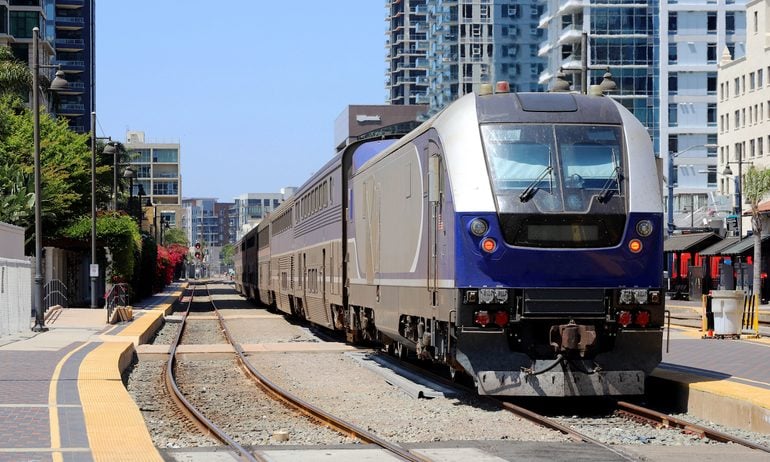Ask a Travel Nerd: Will the U.S. Ever Take Rail Travel Seriously?
Trains are one of the most carbon-efficient modes of transit we have. Does anyone care?

Many or all of the products on this page are from partners who compensate us when you click to or take an action on their website, but this does not influence our evaluations or ratings. Our opinions are our own.
I’m obsessed with a TV show called "Japan Railway Journal." It’s a half-hour English-language show dedicated to new trains and rail lines opening throughout Japan.
Sounds pretty niche, right? Yet snippets of the show are posted to NHK World-Japan’s YouTube channel, which has over 2.5 million subscribers.
What’s striking about the show, beyond the popularity of cute, pink rail cars, is how much pride the locals take in their railways. Being into trains is a thing in Japan.
Contrast that with the U.S., where not only do we lack a single Hello Kitty-themed train line, but also many of us forget about railways when considering travel options. I’ve been writing about travel for over five years now and have written about rail travel — let me check my notes — zero times.
Jokes aside, this nationwide disinterest in trains could have major consequences as we try to reduce the climate impact of transportation. Air travel contributes 11% of total transportation-related emissions in the U.S., according to a White House fact sheet from September 2021, with the trend only going higher. Yet, there’s currently no clear path to making aviation sustainable.
Contrast that with rail travel, which is one of the least carbon-intensive means of travel, according to a December 2022 report from the Congressional Budget Office.
That means we either have to invent a new transportation modality that burns less carbon, or go back to one invented during the Industrial Revolution: railways.
But boosting train ridership isn’t going to be easy.
How many billions?
There is at least one notable U.S. resident who’s a total rail geek: “Amtrak Joe” Biden, who famously commuted between Delaware and Washington, D.C., by train for years.
Biden recently pushed through billions of dollars in funding for Amtrak as part of a larger infrastructure spending effort. That might sound like a big deal for train travel in this country, until you dig into the details.
The spending only affects the Northeast Corridor train line (yes, a single line). A full $3.8 billion is being spent to rehabilitate a tunnel connecting New York to New Jersey. And not a single Pokemon-themed car is included in the enormous spending package.
Basically, this money is being spent to keep the lights on, rather than to make huge improvements that will improve ridership and — by extension — sustainability.
If the federal government spending billions of dollars on railway infrastructure without having much to show for it sounds familiar, you might remember the Obama administration’s efforts to expand high-speed rail. Over a decade later, the U.S. still lacks a single high-speed line (Amtrak’s Acela doesn’t go fast enough to be considered true “high speed”).
Optimists will point to the many high-speed projects under construction or consideration as evidence that rail travel has a future in the U.S. But history seems to indicate that it will take more than a few measly billion dollars to kick America’s flying habit.
One step forward
Technology is changing and improving our lives at a dizzying rate. Chatbots are almost human. Cars are quickly electrifying. Yet technology hasn't improved long-distance travel much in recent decades. In fact, it may be regressing. According to a recent article in the New York Times, nearly every aspect of traveling — from flying to driving — actually takes longer now than it did in the 1970s.
Meanwhile, the travel industry faces an enormous climate dilemma. Commercial aviation emits, on its own, as much carbon dioxide as a large industrial nation on a yearly basis. We can’t keep flying this much without burning way more fossil fuels. Something has to give.
Train travel is hardly cutting-edge technology. When the first commercial steam locomotive was introduced, James Madison was president and the U.S. was at war with Britain. Yet it may be one of our best bets for making travel more sustainable.
But the odds are long. Billions of dollars have already been poured into the country's rail infrastructure, with billions more on the way. Yet no significant changes to where or how quickly we can travel by train are set to come over the horizon.
And we still don’t have a single cute pink train.
How to maximize your rewards
You want a travel credit card that prioritizes what’s important to you. Here are some of the best travel credit cards of 2025:
Flexibility, point transfers and a large bonus: Chase Sapphire Preferred® Card
No annual fee: Wells Fargo Autograph® Card
Flat-rate travel rewards: Capital One Venture Rewards Credit Card
Bonus travel rewards and high-end perks: Chase Sapphire Reserve®
Luxury perks: The Platinum Card® from American Express
Business travelers: Ink Business Preferred® Credit Card
Chase Sapphire Preferred® Card
Travel
Dining
🔥 Huge highest-ever bonus on NerdWallet's 2025 Best All-Purpose Travel Rewards Card is back. Don't miss your rare chance to: Earn 100,000 points when you spend $5,000 on purchases in the first three months. That's worth at least $1,250 toward travel booked through Chase.


